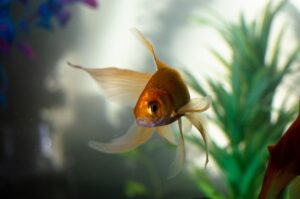How should I care for and keep my goldfish?
How should I care for and keep my goldfish? The goldfish (Carassius auratus), known for its enticing vibrant colours, is the most frequent decorative fish. Goldfish developed in temperate environments and can be found in the wild in frigid streams, lakes, and ponds throughout Asia and parts of Eastern Europe. There are many different types of goldfish to pick from nowadays.
Goldfish are social and intelligent animals that interact with their human caregivers who recognise them on a regular basis. Some goldfish can live for up to 30 years if properly cared for, although the average lifespan is between 10 and 15 years. Unfortunately, due to inadequate living conditions, many goldfish do not survive to their full life expectancy. Housing must meet both their behavioural and physiological requirements. The following information should assist goldfish in living longer, healthier, and happier lives.
Purchasing a healthy goldfish
When purchasing goldfish, be certain that the supplier is trustworthy and that their aquariums are not overcrowded. Healthy fish have a clear, brilliant body colour and straight fins. Healthy fish are aware of their surroundings and swim without expending excessive effort.
Fish that sink or float on the surface, fish with lumps, sores, pinched fins, or a trail of excretions, and fish that remain in the aquarium's corner for an extended amount of time are all symptoms of poor health. When choosing goldfish, keep in mind how big they will grow to ensure that they have enough space as they age.
Aquarium Dimensions
An aquarium must have a minimum volume of 50 litres as well as the following dimensions:
Length is equal to four times the mature fish's body length.
2 times the mature fish's body length = breadth
Height is equal to three times the length of an adult animal's body.
The filter's capacity is also important in the arrangement.
* For your goldfish, a larger tank and filter are preferable.
Consider the size of your fish, the age of your fish, and the number of fish you want to maintain. Certain goldfish species, such as thinner, more active goldfish, may require more space, hence the aquarium size for these species should be larger and longer than is normally recommended for their body size.
Because goldfish are so small, they should not be kept in standard fish aquariums. However, there are some new, modern designs with filtration and illumination that could be a suitable option.
Aeration and filtration
Goldfish are voracious eaters and waste producers, demanding efficient filtration of sufficient size to maintain water quality and aerate the water. Filtration ensures that all water is regularly mechanically and biologically filtered by the nitrifying bacteria in the filter medium. If the filter does not produce air bubbles or agitate the surface water, an aeration system (such as air stones) can be added to ensure that the water is sufficiently oxygenated. This is significant because goldfish generate a large amount of waste.
When selecting a filter, ensure that the flow may be modified. If fancy or unusual goldfish species are to be kept, the flow should be moderate, as rapid currents can make swimming difficult for certain of these fish.
Water conservation
To ensure that debris is eliminated and goldfish health is maintained, gravel cleaning is recommended once a week, in conjunction with weekly partial water changes of 10-25% of the tank water.
A syphon can be utilised; shake the syphon in the aquarium quickly to start the water flow into a bucket below (use a particular fish bucket not used for other purposes to avoid harmful chemical residues). When the syphon is in the tank, suction the substrate to remove any fish waste or uneaten food that has settled on the gravel. To reduce stress, the fish can remain in the aquarium during the syphoning operation. It is critical, however, not to move too quickly, as this may stress the fish.
Throw away and replace the water after 10 to 25% of it has been drained. It is vital that you add a water conditioner (also known as a water conditioner) to the aquarium next to neutralise chlorine and chloramine, as well as gH and kH generators in appropriate quantities for the freshwater you will be adding. After that, fill the aquarium with cold tap water.
When the filter becomes clogged, typically once a month, it should be lightly cleaned in a bucket of aquarium water (whichever comes first). It is crucial not to over-clean the filter medium, as this can kill beneficial microorganisms. If beneficial bacteria are not present, ammonia from fish excretions will not be converted down to less deadly nitrates during the filtering process, resulting in fish poisoning and death.
The interior of the aquarium can be cleaned of algae buildup by gently scrubbing it with a clean, aquarium-safe sponge or a magnetic glass cleaner. Never use soap or detergent to clean an aquarium.
Water Purity
The usage of high-quality water is required for every aquarium to work properly. To ensure the safety of your water, test the levels of ammonia, nitrite, and nitrate on a regular basis to verify that your biological filtration system is in good working order, that it is properly maintained, and that your aquarium is not overstocked or supplied with food.
pH, KH, GH, and water temperature are further water properties to keep an eye on.
Water parameters that are correct
Ammonia concentration of 0.1ppm
Nitrite concentration of 0.2ppm
50ppm nitrate (tolerance 110ppm).
The pH range is 6.5-7.5. (tolerance range: 5.0-9.0)
KH 70-140ppm
GH 150ppm
Temperature range: 20-24°C (temperature tolerance: 8-30°C)
Plant protection
Because goldfish are carnivorous creatures, they require adequate plant cover to minimise stress and promote activity. Plant development is critical for healthy fish because plants absorb waste from the water. Plants are also beneficial to the environment. Natural plants are preferred for planting, but replica plants can be used if necessary. Please make certain that the plants are not poisonous to the fish. Driftwood and decorations can also be used to provide protection.
The greater the amount of cover your goldfish has, the more active it will be. A coverage level of around 50% is recommended. Make certain that your decorations do not have any sharp or rough edges that could harm your fish, as well as any tiny holes that they could become entangled in as they grow. Some unusual species, which are typically not strong swimmers, and goldfish, whose eyesight may be harmed by the disease, are especially vulnerable.
To avoid algal outbreaks, aquariums should be kept away from direct sunlight or windows. Aquarium lights can be activated for up to 8 hours per day.
For additional information, we recommend that you visit a professional aquarist or fish veterinarian. Goldfish with odd body forms may necessitate special care, and more testing is recommended.
The post How should I care for and keep my goldfish? appeared first on https://gqcentral.co.uk




